Infrastructure Challenges Facing Widespread EV Adoption
There have been challenges when adapting to the new trend of electric vehicles.
According to Wards Auto, by examining the breakout of EV infrastructure, it is evident there are significant spatial disparities in charging station placements across the nation. For example, California hosts 29% of all charging stations in America, and the top four states (including California) by GDP and population size have the highest number of chargers. What’s further, nearly all of the top 10 leaders are urban, coastal states.
These numbers indicate there is a need to close the gap, specifically in rural America and areas with lower population density. This buildout of infrastructure in coastal regions versus the lack of access in mid-America shows EVs cannot achieve widespread adoption until the scales are balanced.
This issue is also important to look at through two different lenses: consumer and commercial. From a private vehicle perspective, those who purchase an EV may opt for an at-home charger, making this disparity challenge a non-factor. When thinking about the typical vehicle owner, they are not driving extended distances that require significant amounts of battery power.
From a commercial perspective, it is much more challenging to find adequate charging for an 18-wheel freight hauler that is tasked with driving cross country – though new efforts are starting to take shape. Currently, those rural gaps in infrastructure would pose a major challenge to a commercial driver, especially if the goal is to quickly charge the vehicle.
You may be wondering – are these disparities driven by consumer appetite or by lack of infrastructure? Is the appetite for EVs in urban areas driving faster adoption, or has the investment in charging infrastructure sparked enthusiasm for these populations?
The answer is still uncertain. The green-energy movement in states such as California is vastly different than the push for sustainability in other regions. The “new auto” culture also plays an important role for consumers and EVs.
“New auto” original equipment manufacturers operate differently than traditional automakers. Whereas traditional OEMs know how to build vehicles, these modern enterprises know how to engineer customer-centric vehicles that lead with innovation.
From a customer-experience perspective, “new auto” is designing EVs that consumers view as high tech and aesthetically pleasing. Traditional OEMs are beginning to catch on to these new preferences and branch out into EVs, which may instill an increased appetite for consumers in rural areas – who typically own more traditional internal combustion engine (ICE) vehicles.


